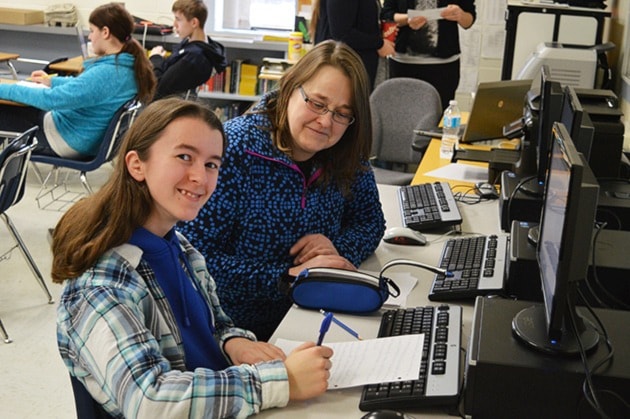Caledonia Senior Secondary School in Terrace, B.C. is moving to increase its support of Grade 10 students after discovering a number of students in that grade are struggling with the challenges of the graduation program.
“We’ve noticed that our Grade 10s as a collective are coming to us, many of them, with gaps in their learning, and with significant issues and struggles,” said Caledonia principal Keith Axelson. “We’ve recognized that we need to do a little more to support them as they enter the grad program.”
Caledonia’s 2015-2016 school growth plan highlights the same significant gaps and challenges facing Grade 10s, specifying the gaps are “particularly in literacy, math and science areas.”
Axelson said Caledonia has focused on Grade 10 since fall 2012, when the high school expanded to include them. That shift followed the 2011 closure of Thornhill Junior Secondary School and the subsequent shift of students. Skeena converted from a Grade 8-10 junior secondary school into a middle school by adding Grade 7, and Grade 10s were moved to Caledonia.
Before that, Axelson said students “coming to us in Grade 11 were one year more mature and already had experience in the grad program.”
Axelson said he believes the challenges stem from the transition into the grad program, with mandatory provincial exams, courses they must pass to graduate and grades that are recorded on transcripts. But he says the Grade 10 curriculum has not changed much since 2012.
“There is always a challenge when you transition from one school to another school, and then throw a new program in there as well and there is going to be a need to help support kids,” he said.
Phillip Barron has been principal at Skeena since before the shift of Grade 10s and he said he does not recall Grade 10 students having a hard time with the grad program. It is the transition between schools that is challenging, he said, and that transition has not changed much for students, other than that they are transitioning at a younger age.
But Caledonia and Skeena work hard together to make the transition between schools smooth, Barron said.
“It is about the kids feeling like they are part of the school and the school culture before they are even enrolled,” he said.
So the source of struggles facing Grade 10 is unknown, but Caledonia is working hard to give support.
In 2013-2014, the school started offering bridge courses for math and science.
“What they are is really preparatory courses for students to transition into a Math 10 and Science 10, so that they can build their skill a little bit and get a better foundation in those areas,” Axelson said.
The support has “had positive results for the students enrolled in these foundational courses,” Caledonia reported in their plan, listing statistics which show that more students are passing Math 10 and Science 10 after taking the extra introduction courses.
Caledonia has also reduced some class sizes. Axelson said courses average 28 students, but if there are a number of students who struggle, sometimes that is too large.
“It’s a matter of taking a look at where your pressure points are,” he said. “It changes year to year depending on the students that you have and the timetable.”
Third, Caledonia started the Kermode Success Program in 2012 to help any First Nations students who struggle with courses and workload. It is a course-block dedicated to working on other courses or correspondence with help from a teacher as needed.
Axelson said if a student is struggling in several courses, the teachers, student and parents may agree to provide a Kermode Success block to replace one of the courses they are struggling in, to give that extra support and help them salvage their other courses.
“We’ve still got lots of room to improve, but we’ve seen some good results with kids staying in school and not dropping out,” Axelson said, adding that there are also more students passing their courses.
Despite the support, Caledonia said in their plan “we also recognized that too many of our Grade 10 students are not engaged in their learning, and do not demonstrate a level of commitment and ownership necessary to achieve success in the graduation program.”
Though that issue extends beyond the school, Caledonia is seeking to do what they can to address that problem through Response to Intervention (RTI), which is an approach to education meant to boost student engagement, understanding and support.
